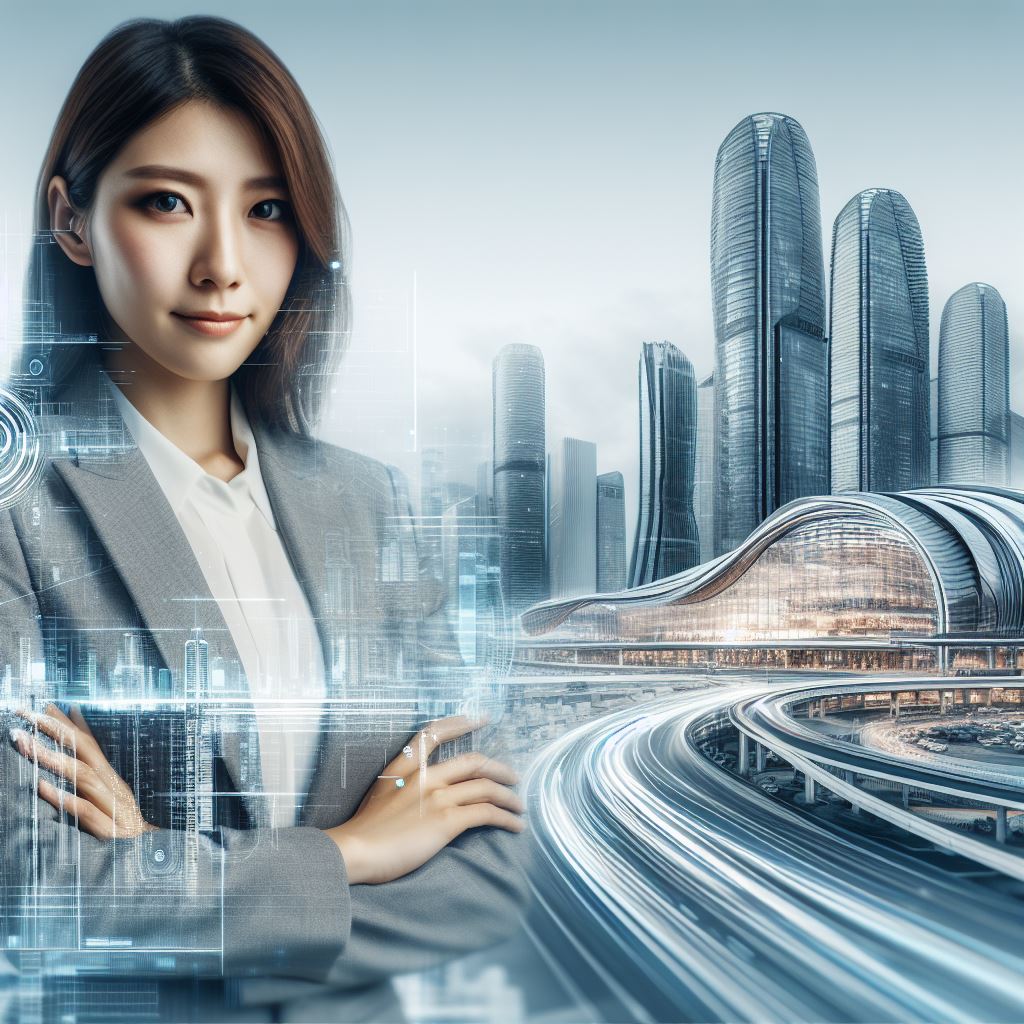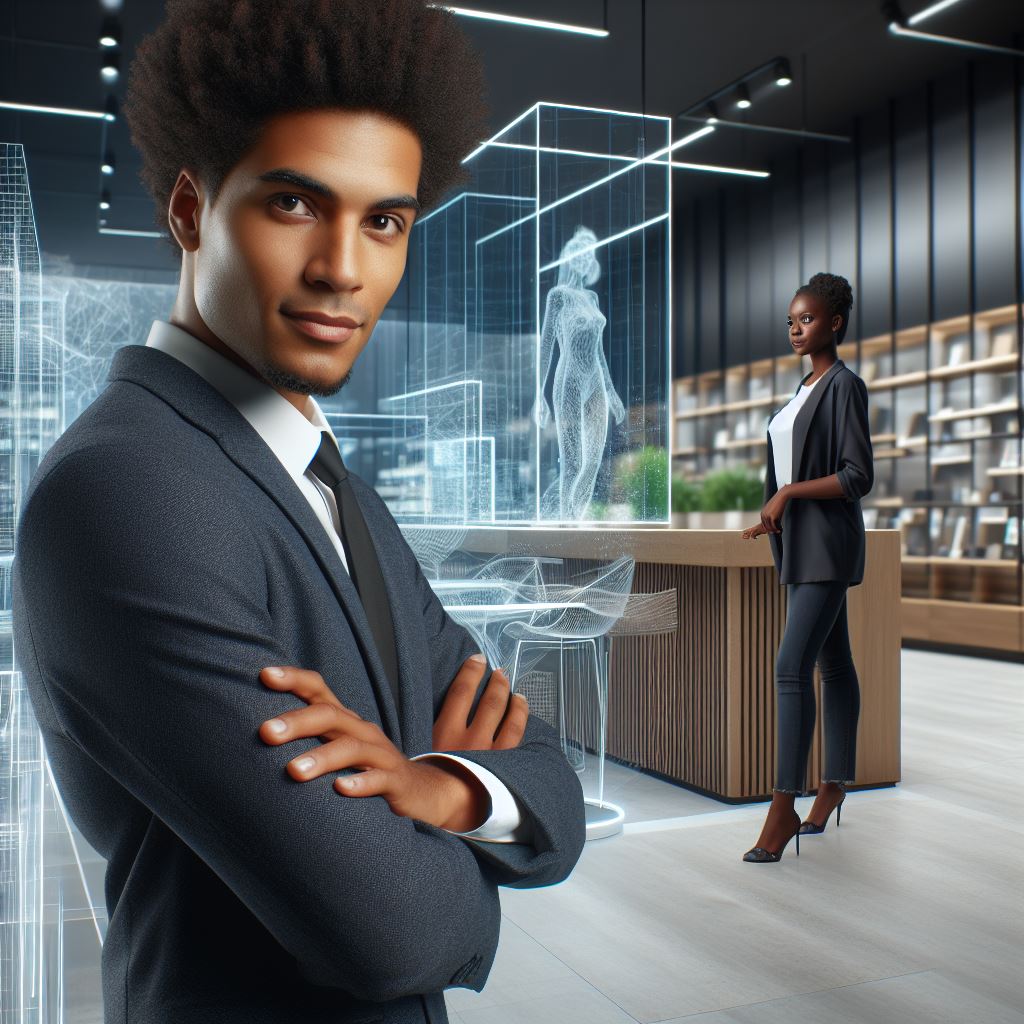Introduction
The landscape of the US retail industry is in a constant state of flux, undergoing rapid transformations driven by shifting consumer preferences, technological advancements, and economic forces.
Traditional brick-and-mortar malls, once bustling hubs of commerce, now find themselves grappling with the challenges posed by e-commerce giants and changing shopping behaviors.
However, amidst this evolution, a new trend is emerging – the rise of high-tech malls.
These high-tech malls represent a paradigm shift in the retail experience, leveraging cutting-edge technologies to redefine the way consumers interact with physical spaces.
From augmented reality fitting rooms to personalized shopping recommendations powered by artificial intelligence, these malls are at the forefront of innovation, seamlessly blending the digital and physical realms to create immersive and engaging environments.
Gone are the days of mundane shopping trips; instead, high-tech malls offer visitors an experiential journey filled with interactive displays, sensory-rich environments, and seamless digital integration.
With features like smart parking systems, interactive wayfinding kiosks, and mobile apps that enhance convenience and accessibility, these malls are setting new standards for customer experience and convenience.
Moreover, high-tech malls are not just about enhancing the shopping experience; they also serve as community hubs, hosting events, entertainment experiences, and cultural activities that foster social connections and community engagement.
By transforming traditional retail spaces into dynamic, multifunctional destinations, these malls are redefining the role of brick-and-mortar stores in the digital age.
In this post, we will delve deeper into the phenomenon of high-tech malls, exploring the technologies driving their evolution, the impact they are having on the retail landscape, and the opportunities and challenges they present for retailers, consumers, and communities alike.
Join us as we embark on a journey to discover the new face of US retail – where innovation meets experience in the high-tech mall of the future.
What are high-tech malls?
High-tech malls are modern retail spaces that incorporate advanced technology to enhance the shopping experience.
Definition and explanation
High-tech malls, also known as smart malls, combine traditional retail elements with cutting-edge technology.
These malls utilize innovative solutions to provide customers with a seamless and interactive shopping environment.
The incorporation of advanced technologies aims to attract and engage tech-savvy consumers.
High-tech malls often feature digital signage, interactive displays, augmented reality, and virtual reality experiences.
These malls leverage data analytics and artificial intelligence to offer personalized recommendations and targeted advertisements.
RFID (Radio Frequency Identification) technology is commonly used in high-tech malls for inventory management and improved customer service.
Some high-tech malls even enable shoppers to make purchases using facial recognition or biometric authentication.
With the integration of mobile apps and smart devices, high-tech malls provide convenient and customized shopping experiences.
Examples of high-tech mall innovations
- Interactive displays: High-tech malls incorporate touchscreens and gesture recognition to allow shoppers to explore products digitally.
- Virtual reality experiences: Visitors can take virtual tours of stores or try on virtual outfits before making a purchase.
- Augmented reality applications: High-tech malls use AR to provide shoppers with additional information about products or create interactive advertisements.
- Smart fitting rooms: These hi-tech fitting rooms allow customers to virtually try on clothes and change colors or sizes with a few taps on a touchscreen.
- Smart mirrors: High-tech mirrors can scan barcodes or RFID tags on clothing items, displaying product information and suggesting matching accessories.
- Cashless transactions: High-tech malls facilitate digital payments using mobile apps, RFID-enabled payment systems, or biometric authentication.
- Delivery robots: Some high-tech malls employ robots to transport purchased items to designated pick-up points or directly to customers’ homes.
- Personalized recommendations: Utilizing AI algorithms, high-tech malls analyze shoppers’ preferences and purchase history to suggest tailored product recommendations.
- Queue management systems: These technologies automate the process of waiting in line, allowing customers to receive notifications when their turn is approaching.
- Smart parking systems: High-tech malls integrate sensor-based systems to guide shoppers to available parking spaces and provide real-time information on parking availability.
High-tech malls are revolutionizing the retail industry by combining convenience, personalization, and technology.
These innovations enhance the in-store experience, making shopping more engaging and efficient for consumers.
With the increasing demand for seamless digital experiences, high-tech malls are at the forefront of shaping the new face of US retail.
As technology continues to advance, we can expect even more exciting and immersive developments in high-tech malls.
So, get ready to embrace the future of shopping!
Read: Future of Shopping Centers: Post-COVID Outlook
Benefits of high-tech malls for retailers
High-tech malls offer numerous advantages for retailers, allowing them to enhance the customer experience, increase foot traffic, and gather valuable consumer data for targeted marketing efforts.
Enhanced customer experience through advanced technology
- Implementing cutting-edge technology in high-tech malls creates a more interactive and immersive shopping environment.
- Virtual reality and augmented reality applications can allow customers to visualize products before making a purchase.
- Interactive kiosks and digital signage enable retailers to provide personalized recommendations and promotions.
- Smart mirrors and fitting rooms equipped with RFID technology enhance the try-on process, offering convenience and efficiency.
- The integration of mobile apps and beacon technology allows for personalized offers and in-store navigation.
Increased foot traffic and sales opportunities
- High-tech malls attract tech-savvy customers who seek innovative and unique shopping experiences.
- The presence of advanced technology within the mall can become a key selling point and draw in new customers.
- Interactive displays and experiential features encourage shoppers to spend more time in the mall, resulting in increased foot traffic.
- High-tech malls often host events and live demonstrations, creating a buzz that drives additional visitors and potential buyers.
- With more foot traffic, retailers have a greater opportunity to showcase their products and services, leading to increased sales.
Ability to gather valuable consumer data for targeted marketing efforts
- High-tech malls provide retailers with access to a wealth of consumer data, allowing them to better understand their target audience.
- Through mobile apps and other connected technologies, retailers can collect information on customer preferences, shopping habits, and demographics.
- This data enables retailers to personalize their marketing strategies and deliver targeted promotions and recommendations.
- By analyzing consumer data, retailers can identify trends, optimize product offerings, and improve overall customer satisfaction.
- Targeted marketing efforts based on consumer data can result in higher conversion rates and improved return on investment for retailers.
In conclusion, high-tech malls offer significant benefits for retailers.
Implementing advanced technology enhances the customer experience, increases foot traffic, and provides valuable consumer data for targeted marketing efforts.
Read: 2024 Retail Spaces: Trends in US Malls & Stores
Benefits of high-tech Malls for Consumers
In today’s digital age, high-tech malls have emerged as the new face of US retail, offering a range of benefits for consumers.
By combining innovative technologies with personalized experiences, these malls are revolutionizing the way people shop.
Convenient and personalized shopping experience
High-tech malls leverage cutting-edge technologies to enhance convenience and provide personalized shopping experiences.
With features like interactive maps, shoppers can easily navigate through the mall and find their desired stores or products.
Additionally, smart shopping carts equipped with scanners allow consumers to easily track their purchases and make payments at self-checkout counters, saving time and eliminating long queues.
Integration of online and offline shopping
High-tech malls seamlessly integrate online and offline shopping, creating a harmonious omni-channel experience for consumers.
Through mobile applications, shoppers can access virtual storefronts that offer an extensive range of products from different retailers.
This integration grants consumers the flexibility to browse and purchase items from the comfort of their own homes, while also having the option to physically visit the mall and try out products before making a final decision.
Access to innovative services and technologies
High-tech malls provide consumers with access to a wide array of innovative services and technologies that enhance their overall shopping experience.
For instance, virtual reality (VR) and augmented reality (AR) technologies allow shoppers to virtually try on clothes, test various makeup looks, or visualize how furniture would fit in their homes.
This not only saves time but also helps consumers make more informed purchasing decisions.
Moreover, high-tech malls often incorporate smart fitting rooms equipped with interactive mirrors that offer product information, alternative options, and personalized recommendations based on shoppers’ preferences and previous purchases.
These high-tech features enhance the overall convenience, efficiency, and satisfaction of the consumer.
Furthermore, technology-driven malls offer consumers access to additional services that go beyond traditional shopping.
Some high-tech malls feature onsite entertainment zones, such as virtual reality gaming centers, indoor theme parks, or immersive cinematic experiences.
These entertainment options provide visitors with a chance to relax, engage in interactive activities, and make their mall visit a memorable experience for the whole family.
Additionally, high-tech malls often host events, workshops, and demonstrations that showcase the latest technological advancements, giving consumers the opportunity to engage with emerging technologies firsthand.
This fosters a sense of community and acts as a platform for consumers to learn and explore new innovations.
In fact, high-tech malls offer a plethora of benefits for consumers.
They provide convenient and personalized shopping experiences, seamlessly integrate online and offline shopping, and grant access to innovative services and technologies.
These advancements not only enhance convenience and efficiency but also elevate the overall shopping experience, making high-tech malls the new frontier of retail in the United States.
Read: Green Buildings: The Future in US Offices?

Challenges in implementing high-tech malls
Implementing high-tech malls comes with various challenges that need to be addressed in order to ensure their success and sustainability.
These challenges include:
Investment costs and sustainability concerns
The implementation of high-tech features in malls requires significant investment in terms of infrastructure, technology, and maintenance.
The costs associated with implementing technologies such as smart lighting, interactive displays, and advanced security systems can be substantial.
Additionally, ensuring the sustainability of these high-tech malls is of paramount importance.
The energy consumption of these technologies should be optimized to reduce environmental impact and operational costs.
Incorporating renewable energy sources and energy-efficient designs can help mitigate these concerns.
Integration and compatibility of various technologies
High-tech malls rely on the seamless integration of various technologies to create an immersive shopping experience.
However, the compatibility of these technologies can be a challenge.
Different systems and devices may operate on different platforms, making it difficult to integrate them cohesively.
Proper coordination and collaboration between technology providers and mall developers are crucial in ensuring that all the technologies work together harmoniously.
This may involve standardizing communication protocols and platforms to enable interoperability and ease of integration.
Privacy and security concerns for consumer data
As high-tech malls gather data on consumer behavior and preferences through various technologies like facial recognition, location tracking, and personalized advertisements, privacy and security concerns arise.
Ensuring the protection of consumer data is essential to build trust between retailers and consumers.
Implementing robust data protection measures such as encryption, secure data storage, and transparent data handling practices is critical to safeguarding consumer privacy.
Compliance with relevant data protection regulations is also essential.
Customer acceptance and technological literacy
While high-tech malls aim to enhance the shopping experience, there may be resistance or reluctance from some customers due to concerns about the complexity and reliance on technology.
Providing adequate training and support to both customers and mall staff is crucial in overcoming this challenge.
Educating customers about the benefits and ease of use of these technologies can help increase acceptance and adoption.
Additionally, user-friendly interfaces and intuitive designs can make it easier for customers to navigate and utilize the high-tech features.
Maintenance and technical support
High-tech malls require regular maintenance and technical support to ensure their smooth operation.
The complexity of the technologies employed may require specialized knowledge and expertise for efficient troubleshooting and repair.
Establishing maintenance protocols and providing timely technical support can help mitigate any disruptions that may occur.
It is essential to have a dedicated team or partnership with reliable technology service providers to address any technical issues promptly and minimize downtime.
Despite these challenges, the implementation of high-tech features in malls presents exciting opportunities for the retail industry.
By addressing these challenges effectively, high-tech malls can revolutionize the shopping experience and attract tech-savvy consumers.
Read: Future of Office Spaces: US Market Predictions
Successful examples of high-tech malls in the US
In the ever-evolving landscape of retail, high-tech malls have emerged as groundbreaking shopping destinations.
These malls incorporate cutting-edge technology and innovative features to enhance the overall shopping experience.
Let’s explore some successful examples of high-tech malls in the US:
Hudson Yards, New York City
Hudson Yards, located in the heart of Manhattan, is a prime example of a high-tech mall.
It boasts augmented reality (AR) experiences, allowing shoppers to virtually try on clothes.
The mall also features interactive digital screens that provide real-time product information and personalized recommendations.
With its advanced security system and contactless payments, Hudson Yards ensures a safe and seamless shopping experience.
Mall of America, Minnesota
Mall of America is the largest shopping mall in the US and embraces technology in various ways.
It is home to FlyOver America, a virtual reality (VR) attraction that takes visitors on a thrilling flight experience above the US.
The mall also offers beacon technology, which sends location-based notifications to shoppers’ smartphones, guiding them to specific stores or deals.
With its high-speed Wi-Fi and mobile charging stations, Mall of America ensures visitors stay connected while they shop.
The Shops at Columbus Circle, New York City
Situated in the iconic Time Warner Center, The Shops at Columbus Circle is renowned for its high-tech features.
It incorporates interactive touch screens that provide detailed information about products and brands.
The mall also utilizes geolocation technology to send personalized offers and discounts based on shoppers’ preferences and location.
With its smart mirrors in dressing rooms, customers can request different sizes or colors without leaving the room.
Westfield World Trade Center, New York City
As a high-tech mall located in Lower Manhattan, Westfield World Trade Center sets a new standard for shopping experiences.
It offers an immersive digital experience, with digital storefronts and virtual reality installations.
The mall also integrates smart technology for parking, allowing visitors to easily find available spots using their smartphones.
Westfield World Trade Center provides a seamless omni-channel experience by offering online shopping and in-store pickup services.
The Grove, Los Angeles
The Grove is a popular open-air shopping center that combines high-tech features with a vibrant atmosphere.
It incorporates a digital kiosk system that allows customers to request assistance, make reservations, and access exclusive offers.
The mall also utilizes advanced video walls to display captivating advertisements and promotions.
With its RFID-enabled wristbands, The Grove offers a cashless payment system and personalized shopping recommendations.
These high-tech malls have achieved remarkable success through their unique features and achievements.
By seamlessly blending technology with traditional retail elements, they have revolutionized the way people shop.
These malls showcase the potential of high-tech innovations in shaping the future of retail, providing customers with unparalleled experiences and convenience.
As the retail industry continues to evolve, we can anticipate even more exciting developments in high-tech malls and their contribution to the retail landscape.
Potential impact of high-tech malls on traditional retail
High-tech malls are revolutionizing the retail industry in the United States, bringing about potential disruption and transformation of traditional retail.
Potential Disruption and Transformation of Traditional Retail
- Embracing technology: High-tech malls integrate technology to enhance the shopping experience and optimize operations.
- Personalized experiences: Using data analytics and artificial intelligence, these malls can personalize offers and recommendations for shoppers.
- Virtual and augmented reality: High-tech malls introduce virtual and augmented reality experiences, allowing customers to virtually try products before purchasing.
- Automated checkout systems: Traditional retail may face challenges as high-tech malls implement self-checkout systems, reducing the need for cashiers.
- Inventory management: High-tech malls leverage automation to improve inventory accuracy and reduce stockouts, negatively impacting traditional retail that falls short in these areas.
- Loss of foot traffic: Traditional retail might experience a decline in foot traffic as customers flock to high-tech malls for their futuristic and immersive experiences.
How High-Tech Malls Complement Existing Retail Spaces
- Omnichannel integration: High-tech malls provide a seamless transition between online and in-store shopping, accommodating customers’ diverse preferences.
- Showrooming opportunities: Traditional retail can benefit from high-tech malls as they allow customers to physically interact with products before making online purchases.
- Collaboration with legacy retailers: High-tech malls can collaborate with traditional retailers to bring their products into the high-tech shopping environment.
- Enhanced customer engagement: High-tech malls offer interactive displays, smart fitting rooms, and personalized recommendations, increasing customer engagement and loyalty.
- Events and entertainment: These malls often host events and entertainment, driving foot traffic to traditional retail within or around their premises.
- Balancing online and offline experiences: High-tech malls integrate online features, such as e-commerce platforms and click-and-collect services, with the physical retail space.
In a nutshell, the impact of high-tech malls on traditional retail can be disruptive, transforming the industry landscape.
However, it’s essential to recognize that high-tech malls can also complement existing retail spaces by providing omnichannel integration, showrooming opportunities, and enhanced customer engagement.
To thrive in this new era, traditional retailers may need to actively embrace technology and collaborate with high-tech malls to leverage their capabilities.
Conclusion
High-tech malls offer numerous benefits such as enhanced customer experience and increased foot traffic.
However, they also come with challenges like costly implementation and potential job displacement.
Despite the challenges, the future prospects and possibilities of high-tech malls are promising.
These malls have the potential to revolutionize the retail industry by incorporating cutting-edge technologies and creating immersive shopping experiences.
High-tech malls could continue to attract a wider range of customers and provide personalized shopping experiences, thanks to advancements in artificial intelligence and data analytics.
This trend may also lead to the integration of augmented reality and virtual reality technologies, further enhancing the immersive experience for shoppers.
Furthermore, high-tech malls have the opportunity to showcase innovative products and services, allowing retailers to stay ahead of the competition.
The integration of mobile apps, smart shelves, and interactive displays can make shopping more convenient, interactive, and efficient.
However, it is crucial for mall owners and retailers to strike a balance between technology and human interaction to ensure a successful and inclusive shopping experience.
They should also be mindful of the ethical implications surrounding consumer data collection and privacy.
Overall, high-tech malls are poised to reshape the future of retail, offering exciting possibilities for both customers and retailers.
By embracing the potential of technology and finding innovative ways to integrate it into the shopping experience, high-tech malls can thrive in the ever-evolving retail landscape.




